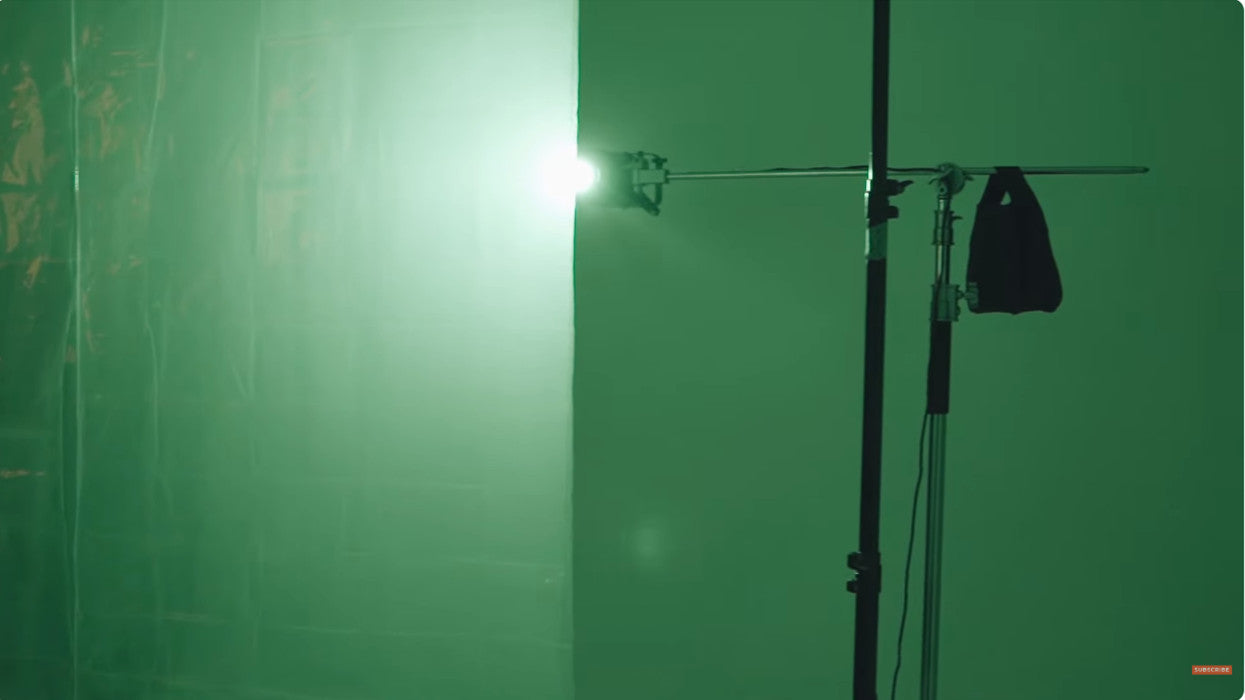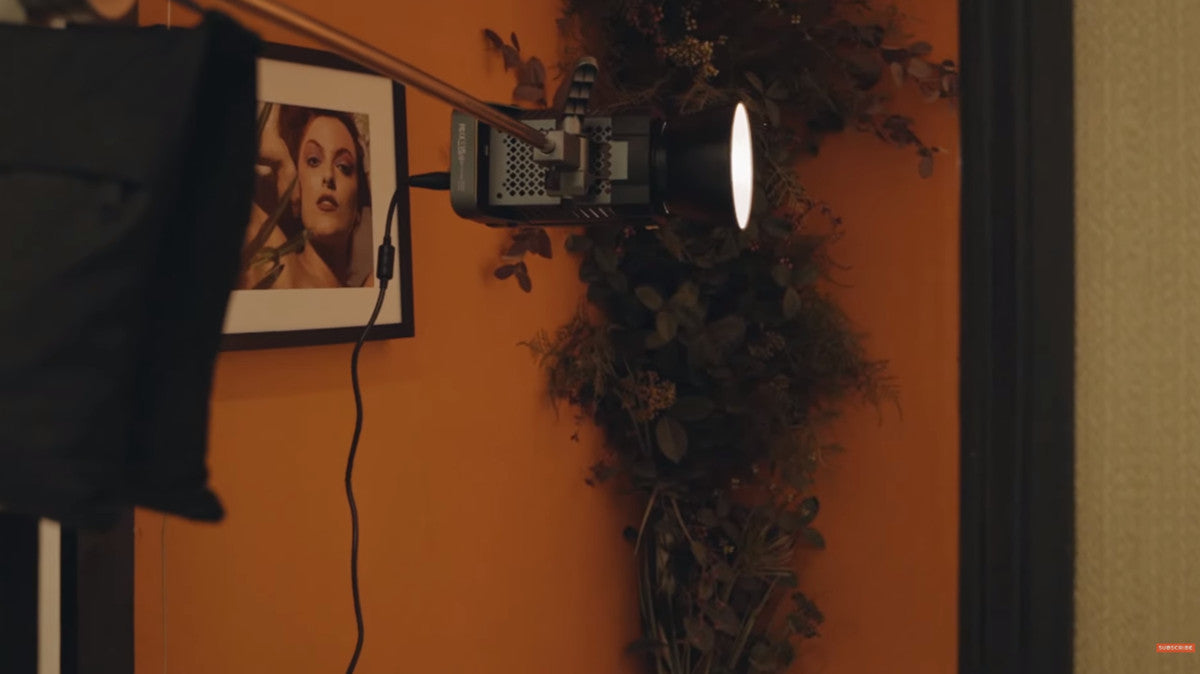RGB continuous light, which uses Red, Green, and Blue LEDs, provides a diverse spectrum of colors by combining these main hues at varying intensities. This versatility makes it particularly useful in a variety of applications, including photography, videography, theater, live events, and even residential and architectural lighting. In this article, we will tell you how to use RGB continuous light in portrait photography by illustrating the video by the YouTuber Sophia Carey. She uses the COLBOR CL220R RGB light for studio and several modifiers to achieve three setups. Read on to see how everything is set up.
Video by Sophia Carey
Setup 1: Use COLBOR CL220R with large softbox to offer overhead continuous lighting for photography

In this setup, the COLBOR CL220R is used with a large softbox and mounted on the light stand with a boom arm for being used overhead. This allows you to create even lighting for photography with only one light. It is also good to use modifiers like V flats or reflectors to create more directions of light or bounce it back. For example, Sophia Carey uses a poly board with the white side facing the subject to add a bit of directional illumination. And a reflector from the floor is used to bounce light to the lower part.
Setup 2: Use continuous lighting and flash together and set CL220R at RGB mode

It is beneficial to use both flash and continuous light for photography together. In this setup, the CL220R is placed behind a sheet of plastic and set at the RGB mode to create different colors of background for portrait photography. It is also placed slightly to the side of the subject to offer side illumination. As for the strobe, it is pointed toward the front of the subject. A slow shutter speed helps the color of the continuous light come through.
Besides the aforementioned setup, there is another way to use continuous and flash lights. Continuous lighting can serve as the primary or key source, offering general illumination and setting the light's direction. Meanwhile, flash can function as the fill or accent lighting, enhancing the scene with depth and contrast. To achieve a balanced exposure, it's essential to measure the exposure using a light meter or histogram and make necessary adjustments.
Furthermore, employing a tripod and a remote shutter release is recommended to prevent any camera shake, especially when working with slow shutter speeds or low ISO settings. Utilizing light modifiers like softboxes, umbrellas, reflectors, or gels can help mold and soften the light, thereby producing various effects. By experimenting with different lighting angles, distances, and the ratio of lights, you can discover the optimal lighting setup that complements your subject and personal photography style.
Setup 3: Use RGB continuous light with supplied reflector to offer hard lighting in photography

It is also a choice to use the CL220R with the supplied reflector to create a direct hard light look. Hard light originates from a direct source, shining straight onto the subject. It might be from the sun, a continuous light, or a flash unit. Because it is so powerful and focused, it produces sharp, well-defined shadows. This type of lighting is excellent for crafting images that are dramatic and rich in contrast.
FAQs about RGB continuous light
What are its benefits in content creation?
Some of the benefits are:
- The constantly on lighting enables real-time previews of your photos or videos, allowing for on-the-fly adjustments to settings and effects.
- It's user-friendly, particularly for novices who might struggle with the complexities of flash or strobe lights.
- The device ensures a steady color temperature and offers the flexibility to produce lighting in any color, featuring complete control over hue and saturation across 360 degrees.
- The lighting it generates is soft and subtle, ideal for enhancing portraits and skin tones.
- It empowers your creative freedom, letting you experiment with various colors to explore their impact on the mood and emotional expression in your photography and videography.
- Its adaptability makes it suitable for a wide range of shooting environments, whether it be indoors, outdoors, in a studio, or for cinematic purposes.
How to choose the best RGB continuous light?
Choosing the best RGB continuous light depends on several factors, such as:
Light output: This relates to the brightness of the light and the area it can illuminate. You want a light with enough brightness to illuminate your subject and scene without causing overexposure or glare. Light output can be measured in lumens, lux, or watts, depending on the type.
Color accuracy: This aspect concerns the light's capability to accurately reproduce the colors of the spectrum without introducing any color cast or distortion. It's important to select a light with a high Color Rendering Index (CRI), as this measures the light's ability to faithfully represent an object's colors. A CRI rating of 90 or higher is deemed outstanding, whereas a rating of 80 or lower is viewed as substandard. Additionally, the color temperature is another factor to consider, as it describes the light's warmth or coolness. Certain RGB lights offer the flexibility to modify their color temperature, allowing you to either complement the surrounding light or achieve various creative effects.
Build quality: This indicates its durability and reliability, as well as its ability to survive normal wear and tear. You want a light that is durable and solidly built, with a metal or plastic shell, along with a design that can withstand heat and resist impact. You also want a light with a long battery life, a reliable power source, and an easy-to-use interface. You may learn more about the light's build quality and performance by checking its reviews and ratings.
Ease of use: This relates to how simple and convenient it is to set up, use, and control the RGB continuous light. You want a fixture with easy-to-use buttons, dials, or switches. Additionally, having the option to control the light remotely via a remote control or an app is beneficial, as it enables you to change the settings and modes from afar. It's also good to seek out a light that comes with either an integrated or removable stand, mounting options, or a handle that allows you to easily position and move it.
Wide color range: Think about the color spectrum and the lighting effect you want to create. Some RGB continuous lights have a restricted color palette, but others have a wider selection. If you want to create a certain hue or look, ensure sure the lights you choose can produce those colors.
What are the uses of RGB continuous light in content creation?
RGB continuous light can create many hues of lighting, allowing you to create diverse effects and moods in your photography or video projects. Some of the applications of RGB continuous light in content creation include:
Background ambience: You may use RGB lights to enhance the color and feel of the background in photography or videography. For example, you may use RGB corner lighting to brighten a dark corner or to create a color gradient on the wall. This might make the camera view more engaging and colorful.
Dramatic scene: RGB lights may be utilized for creating contrast between the foreground and background, as well as between various parts of a scene. You may utilize RGB tube lights to paint the shooting area with multiple colors, or RGB panel lights to simulate candlelight or lightning. This may enhance the separation and depth of your image or video while also creating a dramatic atmosphere.
Creative effects: You may use RGB lights to play around with different colors and observe how they alter the tone and mood of your image or video. For example, you may use RGB ring lights to create a halo effect around your subject, or RGB softboxes to generate a soft, diffused light. You may also utilize RGB lights to match the ambient light's color temperature or use the HSI and RGB modes to generate your own bespoke colors.
